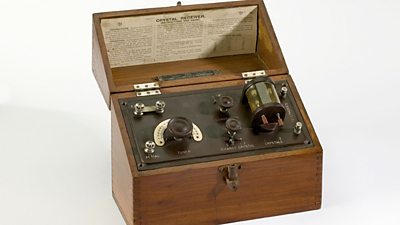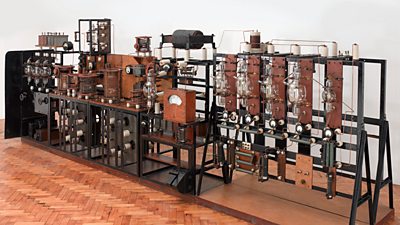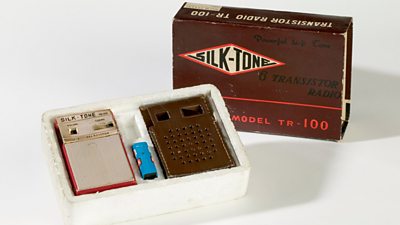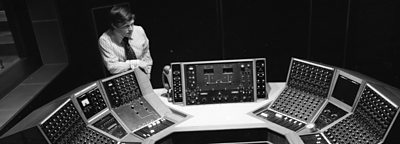Reports of radio’s death were greatly exaggerated. While listening patterns had shifted by 1967 – most strikingly in the evenings, when television had taken over – it still commanded massive audiences. After the launch of Radios 1, 2, 3 and 4, audiences grew considerably, particularly in the daytime, with both Radio 1 and 2 expanding on the listenership of their forerunner, the Light Programme. In this sense, radio was in good health. Yet, there remained a perception that radio, as a mass medium, was more strongly linked with the past than the future.

In his �鶹������ҳ��� Lunchtime Lecture less than two weeks after the launch, the Controller of Radios 1 and 2, Robin Scott, reflected on this negative association, noting that recent events amounted to “Quite a revolution for �鶹������ҳ��� Radio – which used to be called Sound – and even Steam, but I haven’t heard that word bandied about recently”.
-
�鶹������ҳ��� Lunch-Time Lecture by Robin Scott. 11 October 1967
Unlike television in the United Kingdom – which despite initially launching in 1936 was still a relatively recent addition to the broadcasting spectrum, in terms of its mass audience appeal – radio carried its past with it. Audience expectations, behind-the-scenes practices and the increasingly aged technical infrastructure reflected its status as a settled medium, a view the �鶹������ҳ��� now wanted to challenge.
As Scott pointed out in his �鶹������ҳ��� lecture, referencing the London station that had carried the �鶹������ҳ���’s first transmission in November 1922, “Once we had 2LO and a crystal, now we have Radios 1, 2, 3 and 4 and a transistor”.

The transistor radio, first developed in the 1950s but not mass produced until the 1960s, was a revolution in listening that introduced, as Scott put it, “a new factor to radio broadcasting”: “People began to carry their entertainment around with them – and what they wanted was more popular music of all kinds”. It was a liberation from the domestic that made radio mobile, individual and immediate – something television would not be able to compete with until the dawn of more recent digital technologies.

Behind the microphone, the �鶹������ҳ��� was also engaged in the experimental development of radio broadcasting. One particular example was that of stereophonic sound, with the first regular transmissions beginning on the Third Programme in 1962.
Recalling its introduction for the �鶹������ҳ���’s Oral History Collection John Tydeman, then a producer in (and later Head of) Radio Drama explained how the studio floor was marked up with a grid pattern so actors could move while maintaining the stereo effect, “rather like a crossword”. The danger of stereo, he felt, was that its spatial fidelity took the sound of radio “out of the listeners head and placed it on the wall: whereas a radio play takes place inside the skull of the listener …… people became very conscious about people moving to the left and to the right …… the ping pong effect.”
Keeping the balance between a desire to innovate and the need to meet audience expectations could prove difficult. Changing the patterns of radio broadcasting, as in 1967, always risked alienating sections of the �鶹������ҳ���’s audience. This was the case with the 1969 publication of the �鶹������ҳ���’s plan for the future of radio, Broadcasting in the Seventies, which produced a ferocious response.
External factors could also severely limit the ambitions of broadcasters. The launch of Radio 1 on 247 metres medium wave gave the �鶹������ҳ��� coverage of about 86 per cent of the country during the day. However, interference from Albanian broadcasting on the same wavelength in the evening reduced this to 33 per cent.
Similarly, the problem of Needle-time, the amount of recorded music the �鶹������ҳ��� was permitted to broadcast each week restricted the ability of Radio 1, in particular, to meet its claim to be a continuous popular music station. It was one of the reasons Radio 1 and 2 shared the same programmes at certain points in the day.
The history of �鶹������ҳ��� radio encompasses both the steam age of broadcasting and its latest developments: radio, as a medium, intersects it all. It has evolved and expanded to reflect modern sensibilities: technological, aesthetic and as a listening experience. 30 September 1967 was one such step in its evolution that saw the �鶹������ҳ��� embrace the future of radio, especially in terms of popular music programmes, as well as a past steeped in the traditions of public service broadcasting.

